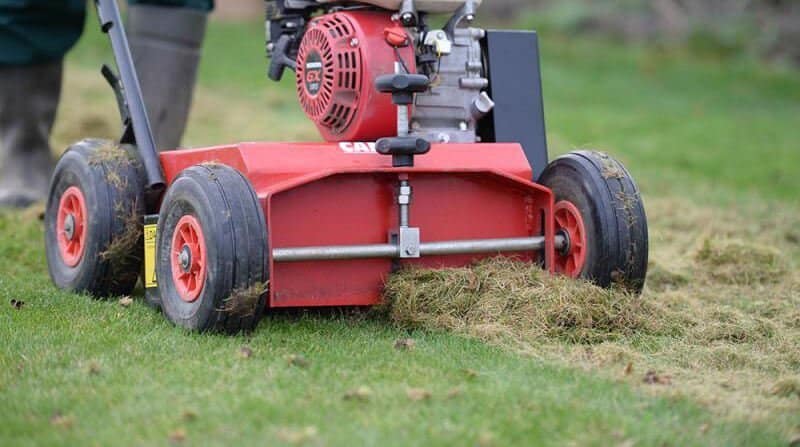Scarification one of the cornerstones of good lawn care and in this article, I’ll show you how to scarify a lawn with a machine or hand tool.
It doesn’t matter;
- Which type of tool you use. Rake or scarifier, powered tool or hand tool.
- If you’re removing moss or lawn thatch.
The process is the same.
What does matter though, is that you understand when you should scarify. Do it either in the spring (April/May) or autumn (September). If it’s not one of these three months you need to wait as conditions won’t be right for recovery.
With that out of the way, let’s get to it.
Preparing Your Lawn For Scarification
Whether you’re scarifying to restore or repair your lawn, or simply as part of your annual lawn care regime, you need to prepare.
You need dry, short grass for scarifying.
So, a week or two beforehand, cut the grass and gradually lower the height of the mower to bring the grass down.
The day before scarifying, mow as close as you can without scalping the lawn.
It’s a good idea to mow the grass short for 3 reasons;
- Scarifying through long grass creates more resistance and you do the grass a lot of damage.
- You’ll ultimately have more mess to clean up, and
- Short grass allows air into the turf which dries the grass.
How to Scarify a Lawn, Step-by-Step
Whether you use a handheld scarifier or a powered machine, the best advice is to go gently.
The best advice is to go gently and cause as little damage as possible.
De-thatching blades will be much harder on your lawn than the wire tines of a rake but either way, gentler you are, the quicker it’ll recover.
The First Pass

If you’re using a powered machine, start off by setting it to its highest setting and scarify in exactly the same way as you’d mow the grass. Go up and down until you have scarified the whole area.
If you’re using a springbok rake or hand scarifier then again, go up and down the lawn, gently teasing out the thatch.
When you have done, gather up all of the debris with a rake, garden vac, or rotary mower.
The Second Pass

Depending on how much material you removed on the first pass, you might choose to lower the scarifier by a setting. The deeper thatch or moss will have been made a little looser from the first pass and so it should come out that bit easier.
If you’re using a rake or hand sacrifier, go a little deeper.
Do the second pass at a 45-degree angle from the first pass so you go diagonally across the lawn.
Once you’ve made your second pass, collect the debris.
If you’re raking in the spring two passes should be enough. However, if you’re removing a lot of thatch or moss in the autumn, you might want to lower the setting and go over the lawn three, even four times.
The Last Pass
On your last pass with the scarifier, use the blades to cut into the soil about a quarter of an inch deep. This will make the perfect bed for laying new grass seed after scarifying.
How to Use a Scarifier
Now you know how to scarify a lawn, let’s look at the different types of scarifier and how to use them to best effect.
The following video from the Lawnsmith is excellent.
Using a Handheld Scarifier
If you only have a small lawn, a hand-held scarifier should do the trick and they’re very simple to use.
Start off in one corner of the lawn and continue down the long edge. Use a back and forth motion and vary the angle of the handle. The higher you raise the handle, the deeper the blades will penetrate the lawn and the more thatch will be removed.
When you make your last pass, you’ll want to raise the handle quite high so the blades cut into the soil to create an open bed for seeding.
Even on a small lawn, using a hand-held scarifier takes significantly longer than a powered version. For that reason, I always use a powered scarifier.
Using a Powered Scarifier
The best powered scarifiers hand changeable cassettes for both raking and de-thatching.
If you’re using an electric or petrol scarifier, it’s just a case of adjusting the height and pushing it around in exactly the same way a lawnmower.
Because you have the option to adjust the height, you might be tempted to set it to its lowest setting and go as deep as you can.
Don’t do this!
Remember I said earlier, the best advice is to go gently. Being too rough with a powered machine can result in you ripping big chunks of turf out of your lawn.
So, find a path, patio or hard surface and adjust the height on your scarifier so the blades just touch the floor. Then, turn it on and go over your lawn for a few meters. Keep making minor adjustments until the thatch comes up without tearing great chunks out of your lawn.
In Conclusion
Learning how to scarify a lawn, either with a machine or hand-held tool is very easy.
The key point I want to stress though is to be as gentle as possible and tease away the moss or thatch. You can scarify heavily but you can also do it gently.
Scarifying with a springbok rake or hand scarifier is a much gentler approach than a powered machine. That said, it’s much more labour intensive.
However you choose to do it, scarifying is important. It’ll breath new life into your lawn and improve the look of your whole garden.

